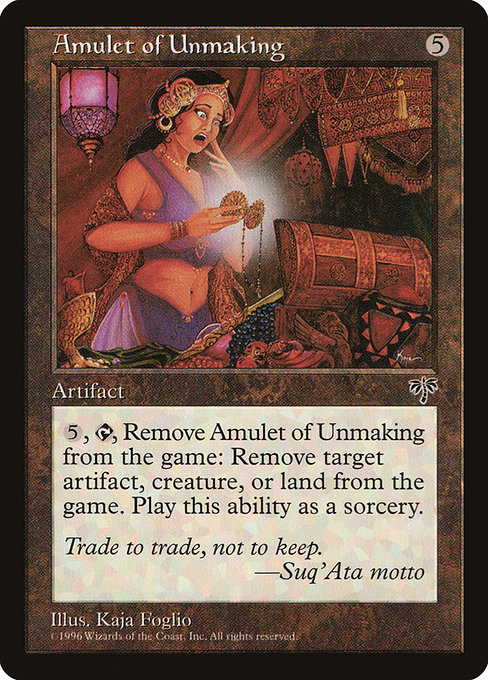
Image courtesy of Scryfall.com
Common misplays around Amulet of Unmaking and how to avoid them 🧙♂️
Amulet of Unmaking is the kind of Mirage-era relic that makes players grin and groan in equal measure. For a modest 5 mana, you get a single, decisive line of exile that can wipe away an artifact, creature, or land—but you’re paying for it with a one-shot, colorless package that vanishes into exile the moment you resolve its ability. That tension between power and cost is what sparks the most memorable misplays. Let’s walk through five frequent slips and how you can sidestep them with the tact and nostalgia that MTG fans adore 🔥💎.
Trade to trade, not to keep. — Suq'Ata motto
1) Trying to use it at the wrong time: “as soon as I hit five mana” syndrome
Because the activation cost includes a fixed 5 mana and tapping the artifact, you’re locked into sorcery-speed timing. A lot of players instinctively snap Amulet of Unmaking out during an instant-speed moment, hoping to erase a problem immediately. In reality, this is a one-shot, sorcery-speed package. If you don’t have a safe main phase window or you’re staring at an open attack, you might waste the mana and the moment. The cure is simple: plan for a clean, safe moment in your main phase when you’re untapped and you know what you want to exile. It’s better to miss a turn than miscast the whole turn by forcing a suboptimal exile just for the sake of using it 🧙♂️.
2) Exiling the wrong permanent: misreading threat priority
The flexibility to exile an artifact, creature, or land is tempting, but not every target is worth five mana. If the field is full of threats you’ll deal with in other ways, or if you exile a land that would soon be required for ramp or color fixing, you’ve just handed your opponent a tempo advantage. The rule of thumb: identify the most impactful threat on the battlefield now—typically a mana rock producing fast acceleration, a dangerous creature that can swing big turns, or a land that unlocks a crucial play—and exile that one. The more you tune your target selection to the immediate board state, the fewer regrets you’ll have on future turns 🧲⚔️.
3) Treating it as a perpetual removal tool rather than a one-shot answer
Some players fall into the trap of treating Amulet as if it’s a reusable spell. Remember: \"Exile this artifact\" is part of the resolution, so the Amulet itself is exiled from your options forever when you use it. There’s no recasting it from the graveyard or replaying it from exile—unless your deck somehow fetches it back, which is rare for a Mirage-era piece. It’s a finite, high-impact play, not a recurring answer. Use it when you truly need that singular exile, not as a bruiser that chips away at your tempo over several turns. This one-shot nature is part of the card’s old-school charm 🎨.
4) Underestimating the mana gate: 5 mana is not cheap even in long games
Five mana is a real investment, especially in decks that lean toward midrange or control where every resource matters. If your plan is to stall the table into a late game, you’ll want to ensure you have the mana engine to back it up or you’re waiting on a critical late-game moment. The misplay here is to cast it haphazardly when you’re not ahead on card advantage or life total—because sometimes the best choice is to pass and let a few more threats be dealt with by other spells or by patience. If you do run this card in a deck, pair it with stable mana rocks and tutors so you don’t find yourself staring at a five-mana fissure with nothing to exile by the time you finally untap 🔥🎲.
5) Ignoring the flavor and the strategic role of exile in a наших formats
Amulet of Unmaking sits in a curious space: it’s flavorful, it’s powerful, and it’s a rare artifact from Mirage’s colorful era. The flavor text—“Trade to trade, not to keep”—isn’t just flavor; it’s a reminder that this card asks you to weigh value against risk. In formats where artifacts and problematic lands appear in abundance, the card’s exile line becomes a strategic instrument rather than a flashy finisher. A common misplay is to overlook this cultural and strategic dimension and treat the card as a generic removal spell. In truth, the Mirage era rewarded tempo, timing, and thoughtful resource management—the same virtues you’ll see play out in the best Amulet of Unmaking moments 🧙♂️.
If you’re building or revisiting a nostalgic commander or vintage shell, think of Amulet of Unmaking as a one-time, big-munition exiler that can swing a late-game board state in your favor—especially when your curve and mana are arranged to deliver the five-mana moment exactly when you need it. The rarity and history add to the collector’s joy, and the artwork by Kaja Foglio still carries that classic Mirage charm, with a little glitter of black-border Mirage mystique. It’s a reminder that true power in MTG isn’t always about tempo; sometimes it’s about the story you tell with a single, decisive exile ✨.
If you’re curious about the practical side of strategy and design across MTG’s many eras, you might enjoy checking out some thoughtful reads from our network. And while you ponder how a Mirage artifact feels in your sleeve, you can keep your desk comfy and game-ready with a certain ergonomically friendly accessory—because long sessions deserve a better chair and a better mouse pad. The connection between play and comfort is real, friends 🎨🧙♂️.
Ready to roll the dice of nostalgia? Explore the practical side of design and play with these reads and links from our network:
Foot-shaped Ergonomic Memory Foam Mouse Pad with Wrist RestMore from our network
- https://blog.digital-vault.xyz/blog/post/reduce-support-load-with-smart-design-principles/
- https://transparent-paper.shop/blog/post/distant-hot-giant-reveals-high-velocity-motion/
- https://blog.digital-vault.xyz/blog/post/azula-always-lies-navigating-un-set-visual-design-limits/
- https://blog.zero-static.xyz/blog/post/bibarel-across-generations-comparing-effects-in-pokemon-tcg/
- https://blog.zero-static.xyz/blog/post/scared-stiff-navigating-enchantments-and-artifact-interactions/